By Barbara Cohen and Jennifer Grier
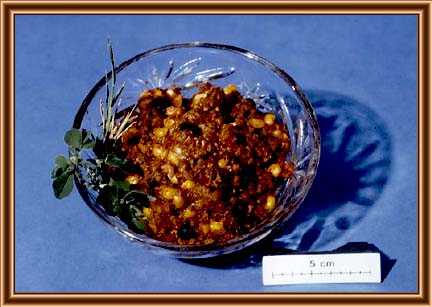
Photo by Maria Schuchardt
In the Spring of 1996, we attended the annual Lunar and Planetary Science Conference in Houston, TX. One of the lonstanding traditions there is a barbecue and chili cookoff to feed and entertain the masses. This was our entry that year, winning us the prize for "best presentation!"
We emphasize that this is all real data. No animals or lab equipment were harmed making this poster.
 Barb stirs up her secret recipe
Barb stirs up her secret recipe
 Ralph and Bob serve as guinea pigs in the test kitchen at Hawthorne House.
Ralph and Bob serve as guinea pigs in the test kitchen at Hawthorne House.
References
Turcotte and Schubert, Geodynamics
Rombauer and Becker, The Joy of Cooking
Weast, ed., CRC Handbook of Chemistry and Physics
Specal Thanks to:
The University of Arizona
The Lunar and Planetary Laboratory
The Planetary Image Research Laboratory (PIRL)
The LPL Beers Crowd
Hawthorne House
Bill Boynton
Chris Capobianco
Kim Cyr
Doug Dawson
Doyle Hall
Ralph Lorenz
Cynthia Phillips
Bob Reid
Kevin Righter
Andy Rivkin
Maria Schuchardt
Zibi Turtle
Abstract
The importance of chili in terrestrial environments has already been well documented (for a basic overview see The Joy of Cooking) yet the properties of the ubiquitous substance have never been well characterized. We have conducted a series of basic but important experiments which not only dramatically increase our knowledge of the physical properties of chili, but may allow for its identification (if present) in meteorites, by space craft, or even remotely by earth based telescopic observation.
First, we obtained a large scale photograph of the chili sample, which clearly shows a matrix of brown-red meat and bean compote, with dark black bean clasts, and yellow corn clasts. Photomicrographs of the chili generated for petrographic purposes reveal tiny beads of oil not visible in the macroscopic view, as well as smaller scale structure in the matrix. It is now clear that several lithologies of chili matrix exist, including meat poor and rich, and oil poor and rich varieties.
Of course, the detailed chemical analysis of the subject chili specimen allow for correlations between visible chili constituents and nutritional content. The high protein content can no doubt be attributed to the meat and bean clasts visible in the photographs, while the fat content may in part be due to the oil visible in the matrix material.
One clue that may help in chili identification is the radioactive nature of the chili, found to be just above expected background. Reflectance spectroscopy reveals several features including a red slope at lower wavelengths and the first possible indication of what we interpret to be a tequila component. This tequila emission feature may be obscuring what we interpret to be a bean absorption feature at approximately one micron. This data may allow for the identification of chili from telescopic observations.
Our calorimetry data were particularly surprising, providing conclusive evidence of at least three distinct phases of chili. The Chili I- Chili II phase transition could provide a thermal marker on other bodies.
Viscosity measurements indicate that the chili behaves as a Bingham fluid under standard pressure and temperature. We speculate that the explosive nature and high gas content of beans and hot chili peppers may cause chili magmas to behave in the fashion of explosive silicic volcanism on Earth. Chili might flow out as large lahars in other planetary environments.
Although we cannot guess as to the extent of this material extraterrestrially, we do believe our data make identification of this unique and delicious substance much more likely if encountered. Please feel free to take a sample for testing in your own laboratory facilities.
Basic Data
Freezing Point (1 bar) >20 F Boiling Point (1 bar) >180 F Density (STP) 1.1 g/cm3 Land Area 756,626 km3 Population (1994) 13,805,000 GNP US $37,064,000,000
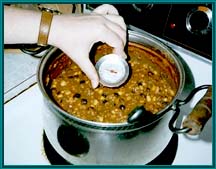 Hawthorne House's precision instruments determine the chili boiling and freezing points.
Hawthorne House's precision instruments determine the chili boiling and freezing points. 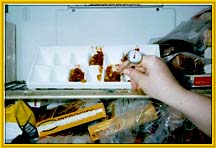
Mass on the triple-beam balance and loose-packed volume give the chili density.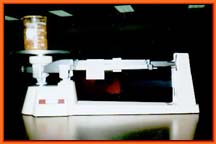
Nutritional Analysis
Courtesy of Elizabeth Turtle
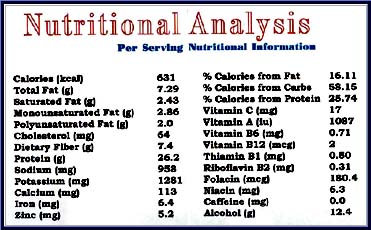
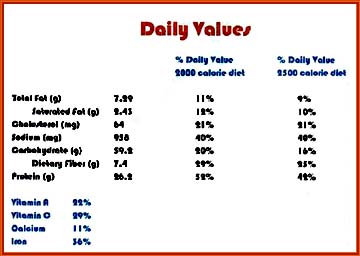
Small-Scale Structure
Magnification 40X
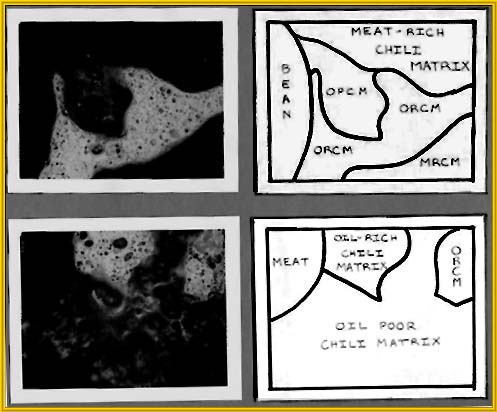
Thanks to Chris Capobianco and Kevin Righter for help in obtaining photographs. We use only the finest Polaroid film in this microscope.
Visible/Near IR Spectrum
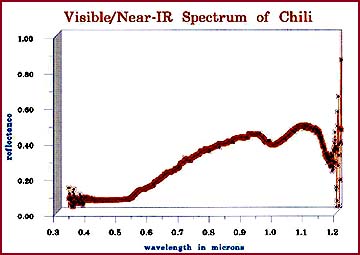
Generally, the spectrum appears red, no doubt due to the abundance of red hot chili peppers. The band centered near 1 micrometer is caused by the Fe2+ -Fe3+ charge transfer absorption in beef muscle. The feature beginning to dip at 1.1 micrometers is the bean absorption. The center of this band shifts according to bean type. Unfortunately, the center is obscured by the tequila emission features at 1.2 micrometers. Tequila-poor chilis in other environments may allow for more confident identification of bean type. This data was teken with the same spectrometer being used to characterize the IMP calibration targets. Comparison with these targets leads us to believe that we could identify chili on Mars with the IMP cameras if chili covers more than 2% of the surface area (B. Reid, personal communication).
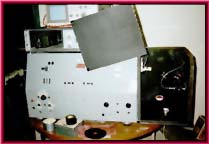 Thanks to Bob Reid for permission to use the Cary-14 Spectrometer.
Thanks to Bob Reid for permission to use the Cary-14 Spectrometer.
Radioactivity
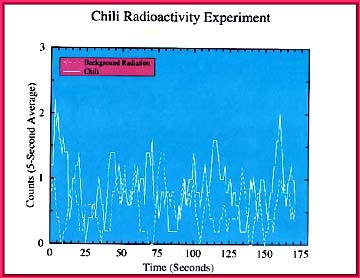
The source of the increased radioactivity in the chili relative to background is unknown. Possible sources include:
- cilantro grown in Nevada Test Site experimental hydroponic gardens
- corn nuclei spontaneously decays in presence of Worcestershire sauce
- high potassium content of chili (see nutritional analysis)
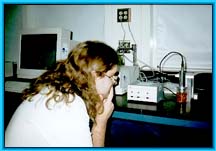 Thanks to Chris Schaller for conducting this test. Data taken with a Geiger tube and Macintosh software, LPL Teaching Lab.
Thanks to Chris Schaller for conducting this test. Data taken with a Geiger tube and Macintosh software, LPL Teaching Lab.
Dynamic Viscosity
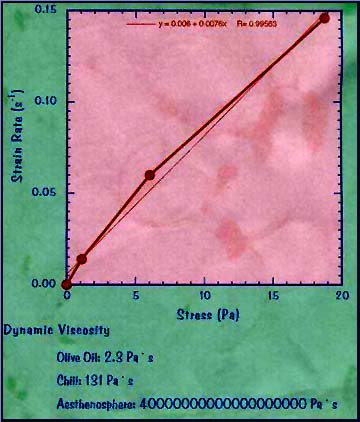
The strain rate of chili over a roughened Teflon surface was compared with the stress at different elevation angles to obtain the dynamic viscosity. The chili behaves as a Bingham fluid and has a viscosity between that of olive oil and that of the earth's asthenosphere. From this data we could infer the behavior of chili flows on other bodies, including the hypothesized large-scale Martian chili lahars.
Thanks to Doug Dawson and Cynthia Phillips for help in the conduction and interpretation of this experiment.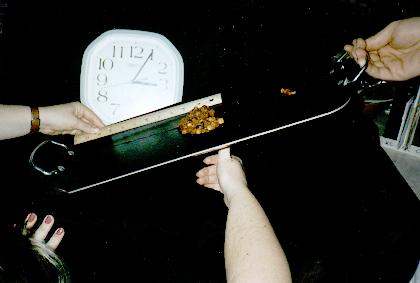
Differential Scanning Calorimetry
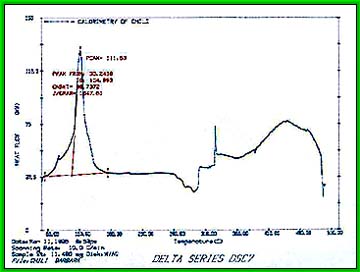
Peak at 98.7 C shows vaporization of water-like components of the chili. Note the elevated heat capacity relative to water. The peak at 330 C is due to the vaporization of extra-virgin olive oil. Trough centered at 290 C shows the transition to amorphous chili, and a small amount of chili transforms into the high-temperature polymorph Chili II at 385 C. The Chili I--Chili II transition would occur at a depth of 40 km. in the earth. Presumably, the state of chili found in extraterrestrial environments will offer clues to the thermal history of that body. Data taken with a Perkin-Elmer DSC. Thanks to Bill Boynton for use of these facilities.

